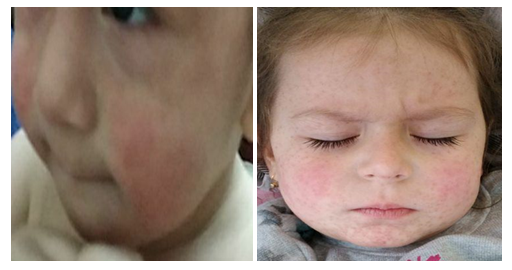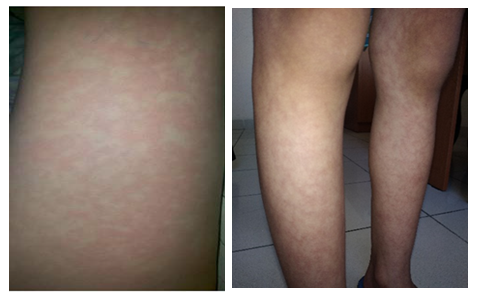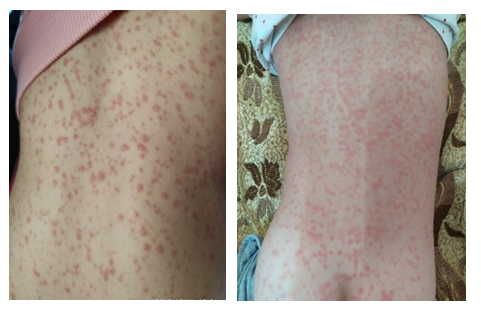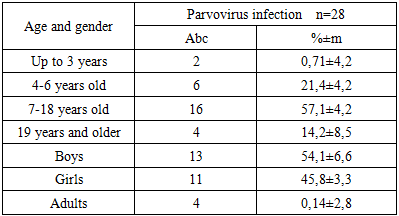-
Paper Information
- Next Paper
- Paper Submission
-
Journal Information
- About This Journal
- Editorial Board
- Current Issue
- Archive
- Author Guidelines
- Contact Us
American Journal of Medicine and Medical Sciences
p-ISSN: 2165-901X e-ISSN: 2165-9036
2020; 10(4): 183-186
doi:10.5923/j.ajmms.20201004.01

Clinical and Laboratory Features of Manifestation of Parvovirus Infection in Children
Lokteva L. M.1, Ibadullaeva N. S.1, Sattarova D. H.2, Aripova G. M.3, Pulatova R. Z.1, Alieva L. E.1, Musabaev E. I.1
1Research Institute of Virology, Ministry of Health of the Republic of Uzbekistan, Tashkent, Uzbekistan
2Department of Pediatric Infectious Diseases, Tashkent Pediatric Medical Institute, Master's Degree, Tashkent, Uzbekistan
3Clinic of the Tashkent Pediatric Medical Institute, Department of Cardiorheumatology, Tashkent, Uzbekistan
Correspondence to: Lokteva L. M., Research Institute of Virology, Ministry of Health of the Republic of Uzbekistan, Tashkent, Uzbekistan.
| Email: |  |
Copyright © 2020 The Author(s). Published by Scientific & Academic Publishing.
This work is licensed under the Creative Commons Attribution International License (CC BY).
http://creativecommons.org/licenses/by/4.0/

In Uzbekistan, it is a first ever study of B19 parvovirus, its clinical manifestations are known poorly. This article is devoted to the study of clinical symptoms and laboratory changes with parvovirus B19 infection in children in the period of the rise of infectious erythema. From January to December 2019, a comprehensive examination of 28 children was conducted. In the investigation of blood serum IgM antibodies to parvovirus B19 ELISA result was positive. At the age from 6 months to 35 years. Established the development of the disease mainly in children of preschool and early school age, more often in boys, with the seasonal rise in April and May. Parvovirus infection has a benign course.
Keywords: Parvovirus infection, Rash, Children, IgM antibodies
Cite this paper: Lokteva L. M., Ibadullaeva N. S., Sattarova D. H., Aripova G. M., Pulatova R. Z., Alieva L. E., Musabaev E. I., Clinical and Laboratory Features of Manifestation of Parvovirus Infection in Children, American Journal of Medicine and Medical Sciences, Vol. 10 No. 4, 2020, pp. 183-186. doi: 10.5923/j.ajmms.20201004.01.
1. Introduction
- There are a number of non-diagnosable conditions that have various clinical masks of both infectious and somatic diseases. Differential diagnosis of these infections is of great epidemiological and clinical importance, since without the correct diagnosis it is impossible to organize epidemiological surveillance and prescribe the correct treatment in each case. Infectious pathology accompanied by acute exanthema presents significant difficulties in the differential diagnosis of other diseases. One of the diseases occurring with a rash is parvovirus infection B19.Parvovirus B19 infection ("fifth disease", infectious erythema) is a common disease worldwide, occurring predominantly in children [5]. The virus belongs to the family Parvoviridae, the genus Erythrovirus [1]. Manifestations of infection depend on the immunological and hematological characteristics of the macroorganism [3]. In the international classification of diseases of the tenth revision (ICD-10), parvovirus infection has the codes: B08.3 - erythema infectious (fifth disease); B97.6 - Parvoviruses as the cause of diseases classified elsewhere; B34.3 - unspecified parvovirus infection. [6]. In 1995, the pathogen was classified as erythrovirus due to its tropism for erythrocyte precursors in the bone marrow and spleen, on the surface of which there is a P-antigen - a membrane receptor that facilitates the penetration of the virus into the cells. [12]. Further, its expression on the surface of mature red blood cells, megakaryocytes, granulocytes, endothelial and smooth muscle cells of blood vessels, hepatocytes and other cells is proved [2].In immunocompetent individuals without hematologic disorders, inhibition of erythropoiesis due to virus replication is subclinical or asymptomatic. In the dynamics of the disease, in addition to anemia, thrombocytopenia may develop. This is especially true for newborns and patients with immunodeficiency. [9].Along with typical acquired clinical forms of parvovirus infection (acute and chronic), atypical (subclinical and asymptomatic), as well as intrauterine parvovirus infection are distinguished [4]. Infectious erythema or “fifth disease” is the most common typical acute clinical form in children. Despite the modern laboratory possibilities of verification of infectious diseases occurring with exanthema syndrome, etiological decoding is rarely carried out, which leads to underdiagnosis, in particular, parvovirus infection [7].In Uzbekistan, until 2019 there were no studies on this issue. Below is a clinical case that demonstrates a certain difficulty in making a clinical diagnosis of “Parvovirus infection” by primary care physicians, rheumatologists and allergists, which contributed to the incorrect diagnosis of this disease.The aim of the work: Determine the main clinical and laboratory features of the manifestation of parvovirus infection caused by the B19 virus in children of different ages.
2. Materials and Methods
- The study was conducted at the Research Institute of Virology, Ministry of Health of the Republic of Uzbekistan. The study is supported by an applied grant (PZ-2017090828) under the Ministry of Innovative Developments and the Ministry of Health. In order to select patients with suspected parvovirus infection, we have drawn up an agreement with City Children's Hospital №1 and the Tashkent Pediatric Medical Institute, clinic with the department of cardiac rheumatology. For the period March-December 2019, 144 samples with a suspected parvovirus infection were collected, of which 28 blood serum for IgM antibodies to parvovirus B19 by enzyme immunoassay (ELISA) was positive. Detection of IgM for parvovirus B19 was performed using the recomWellParvovirusB19 IgMs test system (MICROGEN, Germany) by ELISA in the Reference Laboratory of the Research Institute of Virology, Ministry of Health of the Republic of Uzbekistan.
3. Results and Their Analysis
- Diagnosis of parvovirus infection is a particular problem since this infection has clinical masks of both infectious and somatic diseases. Patients with parvovirus infection with rashes, joint pain, and a sharp decrease in hemoglobin can be treated with other diagnoses in allergology, rheumatology and hematology departments. Analysis of literature data shows that the etiology of 55-60% of allergic rashes remains unclear [8]. We studied 98 blood samples in patients with rashes who were hospitalized in the allergology department of the City Clinical Hospital-1 in Tashkent. The results of serological research showed the detection of IgM for parvovirus B19 in blood in 19 (19.4%) patients. In patients in the cardiac rheumatology department of TashPMI, IgM to parvovirus B19 was detected in 9 (19.5%) patients out of 46 patients with suspected parvovirus infection. In total, out of 144 patients, 28 are positive for parvovirus infection, which accounted for 19.4% of cases; parvovirus infection was detected in patients in somatic hospitals and receiving treatment under other diagnoses.Detection of IgM for parvovirus B19 using ELISA made it possible to unequivocally talk about the role of parvovirus in the development of infectious erythema, aplastic hemolytic anemia and arthralgia in the acute stage. All blood samples were obtained on the 3-4th day of hospitalization of the patient, which made it possible to make a final diagnosis of “parvovirus infection”, prescribe the appropriate therapy and cancel antibacterial treatment in unclear diagnostic cases.In determining the age characteristics of the 28 patients who had to identify IgM to parvovirus B19 most involved in the epidemic process were preschool and school age children (4 to 18 years) - 24 children (85,7% ± 1,4). Of these, preschool age (from 4 to 6 years) - 6 children (21.4% ± 4.2), schoolchildren (from 7 to 18 years) -16 children (57.1% ± 4.2). At the same time, there were only two children under the age of 1 to 3 years old (0.71% ± 4.2). Patients aged 19 years and older accounted for 14.2% ± 8.5 cases (4 patients) (table 1). Our results are consistent with literature, where children of preschool and school age are most often affected by parvovirus infection. [10].
|
 | Figure 1. Symptom of «spanked cheeks» |
 | Figure 2. Lace rash |
 | Figure 3. Spotted rash all over the body |
4. Conclusions
- Parvovirus infection is a common pathology in the world, which is confirmed by various authors. Nevertheless, despite the high prevalence of this infection in our Republic, a diagnosis of parvovirus infection is not made. Parvovirus infection is of great practical importance and can be used in any healthcare sector and will contribute to the timely diagnosis of this infection, namely the formulation of an etiological diagnosis. Parvovirus infection mainly affects preschool children (84% in our observation) and adults. The disease proceeds mainly in the middle form in children, has a characteristic picture of the development of a rash - the form of infectious erythema with the symptom of “spanked” cheeks with transformation into a lace rash without symptoms of intoxication and damage to other organs and systems. Also, all patients have thrombocytopenia and a decrease in hemoglobin, which is characteristic of parvovirus B19.
 Abstract
Abstract Reference
Reference Full-Text PDF
Full-Text PDF Full-text HTML
Full-text HTML